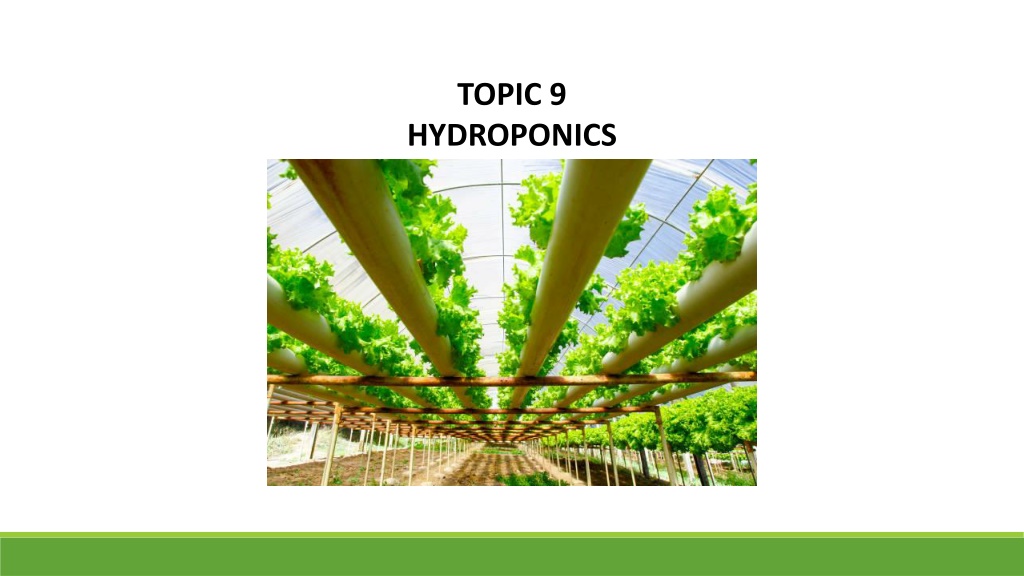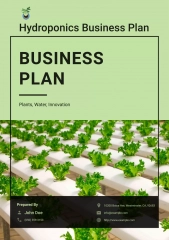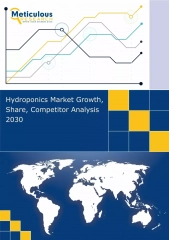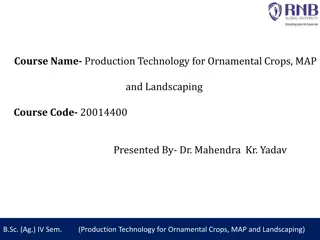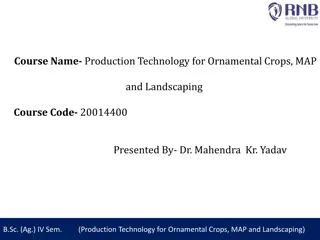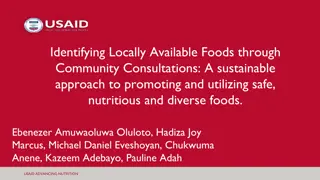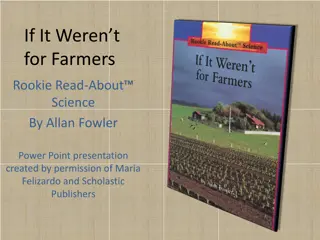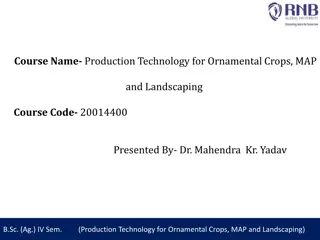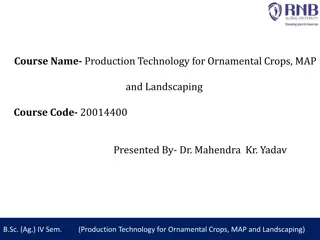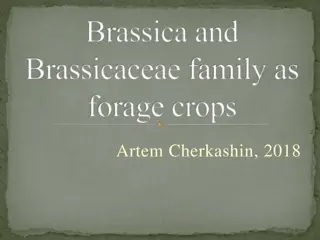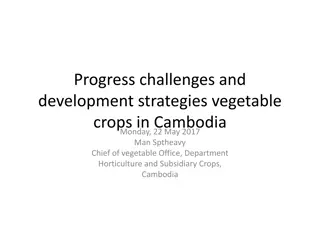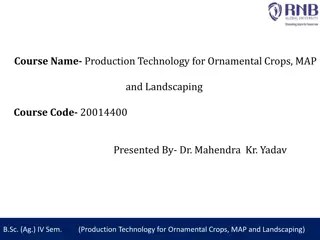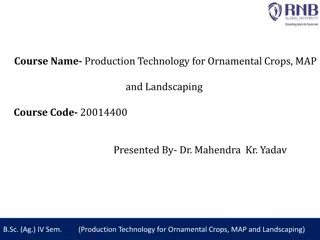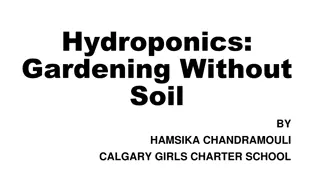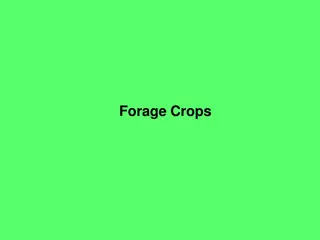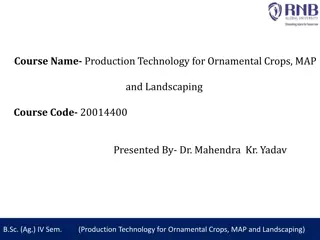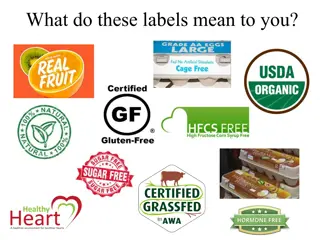Understanding Hydroponics: Methods, Advantages, and Crops
Hydroponics, derived from Greek words meaning "working water," is a soilless plant-growing method. It offers various advantages like efficient water use, pesticide-free produce, and higher yields. Different types of hydroponic systems exist, enabling the cultivation of a wide range of crops. However, challenges such as initial setup costs and pathogen risks through water transmission should be considered. Overall, hydroponics presents a modern and sustainable approach to farming.
Download Presentation

Please find below an Image/Link to download the presentation.
The content on the website is provided AS IS for your information and personal use only. It may not be sold, licensed, or shared on other websites without obtaining consent from the author. Download presentation by click this link. If you encounter any issues during the download, it is possible that the publisher has removed the file from their server.
E N D
Presentation Transcript
TOPIC 9 HYDROPONICS
The term hydroponic comes from two Greek words, which are hydro (water) and ponos (work). Hydroponic generally means working water . However, in practice, hydroponics is a method of growing plants without using soil. Although essentially the hydroponic system does not need soil in a neutral situation, growth depends on various other factors such as light, temperature and environment. These factors can be controlled to produce the appropriate physiological activity in plants. TYPES OF HYDROPONIC SYSTEMS (a) Open hydroponic system; and (b) Closed hydroponic system.
Types of Crops that are Suitable to be Planted using the Hydroponic Method
ADVANTAGES AND DISADVANTAGES OF HYDROPONICS Hydroponics have several advantages compared to the normal cultivation system using soil which are as follows: (a) This system can be applied in areas that are not suitable for normal planting like contaminated lands, deserts and others; (b) Vegetables will quickly grow and produce high quality results; (c) Clean and free from any kind of pesticides; (d) No need to weed, water and hoe; (e) The usage of water and fertiliser is controlled and can be done efficiently; (f) Profits per unit area in a unit of time is high. For example tomatoes grown on land can produce 5 to 10 tonnes per acre per year, compared to 200 tonnes if operated in hydroponics; (g) Medium costs can be saved because it can be recycled after being disinfected; (h) Plant roots will grow better because the supply of water and oxygen is enough;
(i) Nutrients supplied are not wasted as it is used directly by the plants' roots; (j) Planting can be done continuously and with this the growing season can be extended; (k) This system can be easily adapted to plant many other crop species; (l) Fruits produced are more uniform in shape and taste as the nutrient material and pH solution can be controlled continuously and evenly. Uniformity is very important for marketing and exporting purposes; and (m) Plant diseases caused by bacteria, fungi and nematode worms available in the soil can be reduced. However, there are also some disadvantages in hydroponic system such as: (a) Construction of hydroponic systems require a higher purchase cost for the equipment and materials than normal planting; (b) Technical knowledge is required to prepare the nutrient solution, testing the pH and electrical conductivity (EC) as well as the addition of fertilisers; (c) Not all crops are suitable to be grown in this way because of the cost problems and certain technical aspects which need to be addressed; and (d) Many types of pathogens such as fungi and bacteria can be spread through water.
METHODS IN PREPARING HYDROPONICS Nutrient Circulation System Nutrient Circulation System Static Hydroponic System Static Hydroponic System (a) Water pumps for aquariums; (a) Hydroponic Trough (b) Plant area (made of PVC pipe, plastic tray and other (b) Cover (Made of Polystyrene, Plastic) materials such as wood, plywood and steel cans which (c) Small Containers (Plastic Baskets, should be covered with thick plastic sheets); Polystyrene Cups) (c) Tanks for nutrient solution; (d) Electricity; and (e) Small plastic pots (if necessary).
NURSERY BASKET NURSERY BASKET NURSERY MEDIUM NURSERY MEDIUM Nursery baskets are containers used to fill in the Nursery medium composes of materials such as medium and to put seeds of the static hydroponic coconut coir wool, sponges, cotton or rag cloths which crop. can absorb water. The container is made of plastic with holes and This medium is placed in the nursery basket for the placed in the holes of the trough cover. germination of seeds. The hole in the basket is to allow nutrient solutions to The nursery medium will hang through the holes of the diffuse into the support medium and for the roots to basket wall so that it can absorb the liquid fertiliser penetrate outside from the container. solution
Formula for Macro Elements Formula for Element Micro
The following explains the methods to sow by transferring: (a) Small tank, oasis cubes (proliferation medium), satay sticks, seeds and fertiliser are the necessary equipment and materials for the nursery; (b) Seeds (three to four seeds) are put into the nursery medium (oasis cubes) that has been scraped in the middle to insert the seeds in it; (c) Clean water is put into the nursery tank; (d) Seeds that are already put into the nursery medium are pressed by hand to allow water to seep into it for the purpose of seed germination; (e) On the second day (when seeds begin to sprout), fertiliser solution with fifty per cent concentration is put into the nursery container; and (f) On the 10th or 11th day, the seedlings have started growing in the oasis cubes and are ready to be transferred to the expansion container (leave only one fertile tree for each of the oasis cubes).
PRESERVATION Crops grown hydroponically also need rigorous care. There are some things that need to be addressed in the period during the care which includes the following: (a) Lighting; (b) Water control; (c) Control pests and diseases; (d) Fertiliser solution; (e) pH of the nutrient; (f) Training and binding; (g) Pruning and pinching; and (h) Pollination
REVENUE COLLECTION Vegetables or fruits that are matured enough should be harvested. Harvesting is the process of collecting the crop. The crop must be harvested at the right time and done carefully, so that the fruit or vegetable is not ruined or damaged. The ideal time to collect revenue is in the morning. For leafy vegetables such as lettuce, spinach and choy sum the produce should be collected by removing the entire tree. For cucumber, chili, beans and tomatoes trees, the produce must be harvested by picking its fruits. Grading is the process of determining the quality of vegetable crops by size and quality. Crop size is determined by the size of the leaves, fruits and nuts that are harvested.
REVENUE COLLECTION Crop size will be determined by grades which are grade A (large), grade B (moderate) and grade C (small). Besides size, the grade is also determined by the quality of crops; for example, in terms of freshness, having no defects and cleanliness. For the purpose of selling, crops that has been harvested needs to be packed. The quality of the produce that have been collected will degrade if stored in hot conditions. Packing work needs to be done to reduce the deterioration of quality. The harvested crops are washed and then packed to maintain freshness and quality. Transparent plastic papers are suitable to be used to pack the harvest especially for the fruits. Vegetables can also be weighed and tied up before being sold. When harvesting, the following schedule should be recorded
